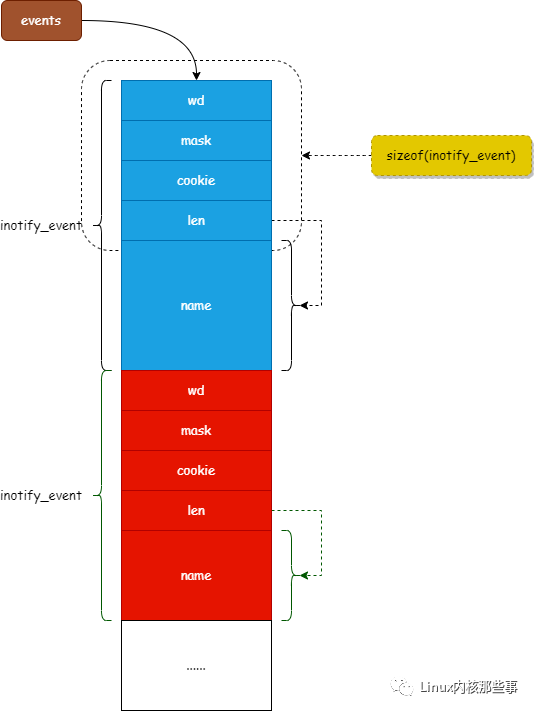监听风云1 - inotify 介绍
不知道大家用过 Dropbox 没有,这是国外一款非常好用云盘,你只需要在 Dropbox 中设置好要同步的目录,每当此目录中的文件发生变动时,Dropbox 就会自动把文件同步到云端。
那么,Dorpbox 是怎么知道目录的文件发生了改变呢?答案是,通过 inotfiy 这个系统功能来实现的。
我们主要分为两篇文章来介绍 inotify 这个功能:本篇首先介绍 inotify 的使用方式,而下篇主要介绍 inotify 的实现原理。
inotify 接口们
其实 inotify 的接口比较少,只有3个:inotify_init、inotify_add_watch 和 inotify_rm_watch。下面我们介绍一下这三个接口的作用和原型。
1. inotify_init
inotify_init 函数用于创建一个 inotify 的句柄,可以认为此句柄就是 inotify 的对象。其原型如下:
int inotify_init(void);
2. inotify_add_watch
创建好 inotify 句柄后,就可以通过调用 inotify_add_watch 函数添加要进行监听的文件或者目录。其原型如下:
int inotify_add_watch(int fd, const char *path, uint32_t mask);
inotify_add_watch 调用成功后,会返回被监听文件或目录的描述符。下面介绍一下各个参数的意义:
fd:就是通过inotify_init函数创建的inotify句柄。path:要监听的文件或目录的路径。mask:要监听的事件,其事件类型如下:
| 类型 | 描述 |
|---|---|
| IN_ACCESS | 文件被访问 |
| IN_ATTRIB | 文件元数据改变 |
| IN_CLOSE_WRITE | 关闭为了写入而打开的文件 |
| IN_CLOSE_NOWRITE | 关闭只读方式打开的文件 |
| IN_CREATE | 在监听目录内创建了文件/目录 |
| IN_DELETE | 在监听目录内删除文件/目录 |
| IN_DELETE_SELF | 监听目录/文件本身被删除。 |
| IN_MODIFY | 文件被修改 |
| IN_MOVE_SELF | 受监控目录/文件本身被移动 |
| IN_MOVED | 文件被移 |
| IN_OPEN | 文件被打开 |
| IN_ALL_EVENTS | 以上所有输出事件的统称 |
3. inotify_rm_watch
inotify_rm_watch 函数用于删除被监听的文件或目录,其原型如下:
int inotify_rm_watch(int fd, uint32_t wd);
下面介绍一下各个参数的意义:
fd:调用inotify_init函数返回的inotify句柄。wd:由inotify_add_watch函数的返回被监听文件或目录的描述符。
读取变动事件
介绍完 inotify 的接口后,现在通过一个简单的例子来展示怎么使用 inotify。在编写 inotify 的实例前,先介绍一下怎么获取被监听文件或目录的变动事件。inotify 并没有提供特定的接口来获取被监听的文件或目录的变动事件,而是通过通用的 read 函数来读取,我们来看看 read 函数的原型:
int read(int fd, void *events, size_t len);
下面说说各个参数的意义:
fd:由inotify_init创建的inotify句柄。events:存放变动事件的缓冲区。len:缓冲区的大小。
events 参数用于存放被监听文件或目录的变动事件,一般指定为 inotify_event 结构的数组,inotify_event 结构的定义如下:
struct inotify_event {
int wd; // 被监控文件或目录的描述符(由inotify_add_watch)
uint32_t mask; // 变动的事件
uint32_t cookie; // 比较少使用,可以忽略
uint32_t len; // name的长度
char name[]; // 用于存放发生变动的文件或目录名称
};使用实例
现在我们可以使用 inotify 来编写实例了,这个实例主要介绍怎么使用 inotify 监听一个文件或者目录,并且打印其变动事件。
实现代码如下:
#include <stdio.h>
#include <string.h>
#include <stdlib.h>
#include <sys/inotify.h> // 引入 inotify 的头文件
/*
* 用于打印发生的事件
*/
void display_event(const char *base, struct inotify_event *event)
{
char *operate;
int mask = event->mask;
if (mask & IN_ACCESS) operate = "ACCESS";
if (mask & IN_ATTRIB) operate = "ATTRIB";
if (mask & IN_CLOSE_WRITE) operate = "CLOSE_WRITE";
if (mask & IN_CLOSE_NOWRITE) operate = "CLOSE_NOWRITE";
if (mask & IN_CREATE) operate = "CREATE";
if (mask & IN_DELETE_SELF) operate = "DELETE_SELF";
if (mask & IN_MODIFY) operate = "MODIFY";
if (mask & IN_MOVE_SELF) operate = "MOVE_SELF";
if (mask & IN_MOVED_FROM) operate = "MOVED_FROM";
if (mask & IN_MOVED_TO) operate = "MOVED_TO";
if (mask & IN_OPEN) operate = "OPEN";
if (mask & IN_IGNORED) operate = "IGNORED";
if (mask & IN_DELETE) operate = "DELETE";
if (mask & IN_UNMOUNT) operate = "UNMOUNT";
printf("%s/%s: %s\n", base, event->name, operate);
}
#define EVENTS_BUF_SIZE 4096
int main(int argc, char const *argv[])
{
int fd;
int nbytes, offset;
char events[EVENTS_BUF_SIZE];
struct inotify_event *event;
fd = inotify_init(); // 创建 inotify 句柄
if (fd < 0) {
printf("Failed to initalize inotify\n");
return -1;
}
// 从命令行参数获取要监听的文件或目录路径
// 添加要监听的文件或者目录, 监听所有事件
if (inotify_add_watch(fd, argv[1], IN_ALL_EVENTS) == -1) {
printf("Failed to add file or directory watch\n");
return -1;
}
for (;;) {
memset(events, 0, sizeof(events));
// 读取发生的事件
nbytes = read(fd, events, sizeof(events));
if (nbytes <= 0) {
printf("Failed to read events\n");
continue;
}
// 开始打印发生的事件
for (offset = 0; offset < nbytes; ) {
event = (struct inotify_event *)&events[offset]; // 获取变动事件的指针
display_event(argv[1], event);
offset += sizeof(struct inotify_event) + event->len; // 获取下一个变动事件的偏移量
}
}
return 0;
}上面的实例逻辑比较简单,主要步骤如下:
- 调用
inotify_init函数创建一个inotify句柄。 - 从命令行中获取要监听的文件或目录路径,并且通过
inotify_add_watch函数把其添加到inotify中进行监听。 - 在一个无限循环中,通过
read函数读取被监听的文件或目录的变动事件,并且通过调用display_event函数打印事件。
上面实例比较难懂的就是从 events 参数中获取变动事件的指针,我们可以通过下面这幅图来理清获取变动事件指针的逻辑:
通过上图,就比较容易理解怎么从 events 缓冲区中获取到变动事件的指针了。
最后,来看看我们编写的实例的效果动画:
总结
本文主要介绍 inotify 的使用,在下一篇文章中,我们将会介绍 inotify 的原理和实现,敬请期待(当然对 inotify 的实现没兴趣的就不用期待了...)。


